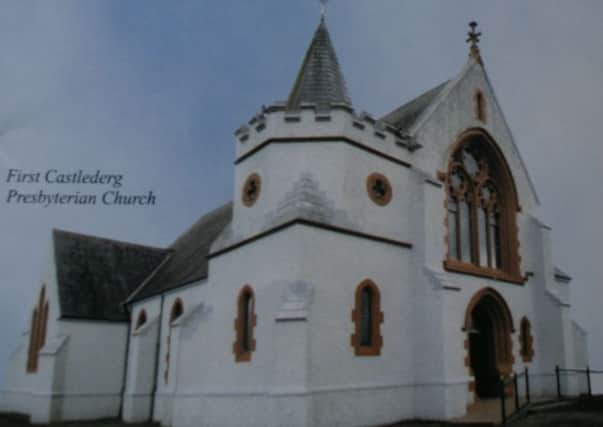Five of the 24 church members who served in WWII didn't return


Those words by James A. Emery introduce his most recent publication ‘Garvetagh, World War II Memories’.
Mr Emery has written and compiled over a dozen books and booklets, mostly about days of yore in and around Castlederg with an emphasis on two World Wars, the Orange Order and the Royal Black Institution.
Advertisement
Hide AdAdvertisement
Hide AdHe has also recounted the history of the local Boys Brigade, the High School, and has written extensively about Castlederg and its evocatively named Red River Valley.
His latest publication refers in particular to a glass-framed Roll of Honour in the Presbyterian Church which bears the names and photographs of 24 local folk who “answered the call of the nation.”
If you google Garvetagh on the worldwide web you’re offered only a lonely statistic about “a small village in County Tyrone, Northern Ireland, near Castlederg. In the 2001 Census it had a population of 66 people.”
Along with photographs, press cuttings and archived documentation, James Emery has compiled 40 pages of “personal details” and “individual biographies” from one Roll of Honour in the vestibule of First Castlederg Presbyterian Church that’s set on a wall surrounded with memorials and commemorations to many other local people.
Advertisement
Hide AdAdvertisement
Hide AdWhile outlining their stories of wartime courage and sacrifice, James has vividly embraced the colour and personality of a little village, like many in Northern Ireland, with a very proud heritage - a lively and caring community with a distinctive past.
His WWII memories are of 19 local people who served and returned and “five who made the supreme sacrifice far from their native homeland.”
Rev Colin Corkey, a former missionary in China and R.A.F. Chaplain, was minister of the church from 6 August 1947 until he moved to Belfast’s Albert Street congregation in 1952.
Rev Corkey’s daughter Frances Corkey Thompson, in her foreword to the book, recalls moving into Garvetagh Manse with her parents when she was three years old.
Advertisement
Hide AdAdvertisement
Hide Ad“Garvetagh was the place where I not only gained three brothers,” her foreword begins, “but also where I began to be aware of the world beyond family.”
Francis was eight when they moved on to Belfast “but the five Garvetagh years are lodged in my consciousness.”
The name of the village had always “conjured for me a far-away, almost dream place, long ago and lost.”
But without knowing it - till she perused an early draft of Mr Emery’s book - “Garvetagh has been closer to me than I could have imagined.”
Advertisement
Hide AdAdvertisement
Hide AdWhen she was in her mid-20s Frances lived and worked in Tunisia, just a few miles away from the Medjez-el-bab War Cemetery.
Fusilier William Thomas Kerr of Golan Cottage, Castlederg, is buried there.
Aged 27 and serving with the Royal Irish Fusiliers in North Africa, William died in action in April 1943.
More recently, while visiting some of the War Graves in Northern France with her husband, “had I only known” admits Frances, “I’d have searched for the grave of Trooper Joseph Burke, born in Coolnacrunaght, at rest in Bayeux.”
Advertisement
Hide AdAdvertisement
Hide AdThe 20-year-old motorcycle messenger with the Reconnaissance Corps was killed in action in August 1944.
“These young men are two of the five from First Castlederg who gave their lives in the war,” Frances’s foreword continues, “I am proud that my father saw fit, as soon as he got to Garvetagh, to have those five honoured in a memorial, along with the others who served and came home.”
The names of local townlands garnish biography with geography as James Emery remembers Georgina Love from Magheracriggan, who served with the Women’s Royal Naval Service, along with her brother William who was with the RAF.
James Glen was from Ballylennon.
Royal Engineers Lance Corporal Robert Verner, who died in a Japanese POW Camp, was from Coolcreaghy.
Advertisement
Hide AdAdvertisement
Hide AdWilliam Caldwell who served with the Royal Scots Regiment came from Carrickadartans.
“I am astonished at the size of some of the families back then,” Frances Corkey Thompson writes in the book’s foreword.
James Emery confirms her astonishment by listing the names of Georgina and William Love’s siblings - Andrew, Rebecca, Mary, Emma, Sadie, Bobby, Noel and Annie.
George Albert Forbes from Clare, Castlederg, waved goodbye to his parents and eight brothers and sisters to serve with the Royal Horse Artillery.
Advertisement
Hide AdAdvertisement
Hide AdThe book includes poignant reminders of wartime shortages and security measures on the home front - an identity card and clothing coupons, sombre clouds on the silver lining that adorned a local newspaper on 17 October 1945 - an advertisement for the Welcome Home Dance for members of H.M. Forces with music by the Monty Dance Band.
The newspaper later reported that “games and dancing were carried on until the morning hours”!
Life after war is also recounted in the book, with some folk staying in the village as farmers, or as bus and lorry drivers or moving to work in other towns in Northern Ireland.
Corporal Andrew Bogle stayed on - as a milk lorry driver and fireman.
Advertisement
Hide AdAdvertisement
Hide AdArmy Transport driver and Normandy Landing veteran William Rutledge opened a shop in Belfast, even though he lost his sight in an accident during a post-war ‘clean up’ operation.
Leading Wren Mildred Young went to Australia and married a farmer in New South Wales.
For further details about ‘Garvetagh, World War II Memories’ e-mail [email protected]